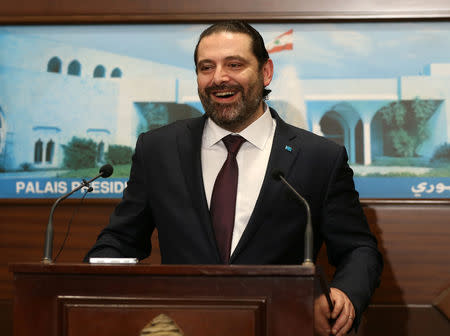Factbox: Lebanon's Hariri forms third government

BEIRUT (Reuters) - Sunni politician Saad al-Hariri formed his third Lebanese government on Thursday after rival factions agreed a national unity cabinet, nearly nine months since an election.
Below are some key phases in his political career:
* Hariri, 48, has been Lebanon's leading Sunni since the 2005 assassination of his father, Rafik. The early years of his political career were defined by his close alliance with Saudi Arabia and confrontations with Lebanese allies of Syria and Iran, chief among them the heavily armed Shi'ite group Hezbollah.
A U.N.-backed court has charged five Hezbollah members over his father's killing. They have been tried in absentia by the U.N.-backed tribunal at The Hague. The group denies any role. Hariri has said he is not seeking revenge for the killing.
* He formed his first coalition government in 2009 after the anti-Syria and anti-Hezbollah coalition he led at the time won a parliamentary majority with Saudi backing. That "March 14" alliance gradually disintegrated in the years that followed.
His cabinet was toppled in early 2011 when Hezbollah and its allies quit over tensions linked to the Hariri tribunal. In the following years, Hariri mostly stayed outside Lebanon on security grounds.
As the war in Syria escalated, Lebanon became paralysed by tensions linked to the conflict. Hariri spoke out against Hezbollah's role fighting in support of President Bashar al-Assad. Political deadlock meant the presidency fell vacant when Michel Suleiman's term ended in 2014.
* In 2016, Hariri stunned Lebanon with a proposal that would see him return as prime minister and deliver the presidency to Maronite politician Suleiman Franjieh, a Hezbollah ally and a close friend of Assad. The idea failed to gain traction as Hezbollah stuck by another of its Christian allies, Michel Aoun, as its candidate for the presidency.
* Later in 2016, Hariri struck a deal with Aoun's party that resulted in him becoming prime minister for a second time and delivered the presidency to Aoun. Hariri formed his second coalition government. He remained an opponent of Hezbollah but his focus was largely on Lebanon's economic problems.
Anti-Hezbollah hawks have accused him of compromising with the Shi'ite group and abandoning the original principles of "March 14".
* Hariri's ties with Saudi Arabia have suffered in recent years, hitting a low in November 2017 when it is widely acknowledged that Riyadh forced him to resign and held him in the kingdom. Saudi Arabia and Hariri publicly deny this version of events, though French President Emmanuel Macron confirmed at the time that Hariri was being held in Saudi Arabia.
After French intervention, Hariri returned to Beirut and retracted his resignation, with the Lebanese government reiterating its policy of neutrality in regional conflicts. This mainly aimed to address Saudi concerns about Hezbollah's support for the Houthi rebels in Yemen.
Hariri remains a focal point for Western support. In April, France hosted an international conference where donors pledged more than $11 billion in assistance on condition Lebanon carried out long-delayed economic reforms.
* Hariri's Future Movement lost more than a third of its seats in the 2018 parliamentary election, some of them to Hezbollah allies. Hariri attributed this to a new election law that awarded seats on a proportional basis. He also blamed the shortcomings of Future and has sacked some top party officials.
* The collapse of Hariri's Saudi-based construction firm Saudi Oger has weighed on the finances of his political network in Lebanon in recent years. Saudi Oger was the source of much of the wealth that helped establish the Hariris as Lebanon's leading Sunni family after the 1975-90 civil war.
(Writing by Tom Perry; Editing by Alison Williams)

